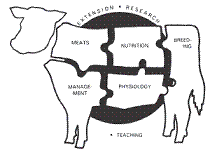Animal Science, Department of

Nebraska Beef Cattle Reports
Date of this Version
2017
Citation
2017 Nebraska Beef Cattle Report. University of Nebraska Extension MP104. Lincoln, NE.
Abstract
Although key to the efficiency of a cattle operation, feed intake is challenging to evaluate in a grazing setting. However, even within forage- based systems, plant- wax markers may be used to predict dietary choices and feed intake. Plant- waxes are a complex mixture of lipids found on the surface of plants. When sufficiently unique among plants, the composition of diets can be determined from the pattern of these compounds in the forages ingested. These markers were used to delineate the parts of the corn plant and, separately, 8 western rangeland grasses and legumes. Using plant waxes, the components of the corn plant were clearly distinguished. Th is technique therefore could be useful in a monoculture, such as a corn residue field, to determine the plant parts predominating in the diet. Delineating plants in a complex sward was more difficult, particularly among like species. Th e use of more markers may help to more explicitly distinguish plants within diverse pastures, such as western rangelands.
Included in
Large or Food Animal and Equine Medicine Commons, Meat Science Commons, Veterinary Preventive Medicine, Epidemiology, and Public Health Commons


Comments
© 2016 The Board of Regents of the University of Nebraska.